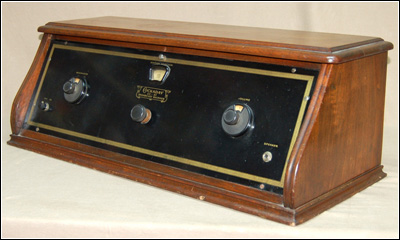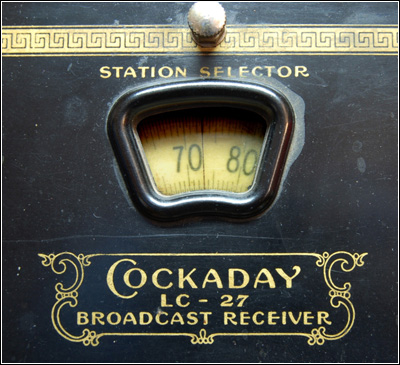Of Old Radios And Related Items--Published Monthly
The Cockaday LC-27 Kit and Circuit
BY ART REDMAN
Web Edition
Once again Art Redman pursues his research on Pacific Northwest radio manufacturers. His interest in the Cockaday Co. leads him to a search for the real thing. (Editor)
Laurence M. Cockaday designed several battery radio receivers along with shortwave sets bearing his name. Among them are the Cockaday Models LC-26 and LC-27, as well as the SC11, 620, and 630 marketed by Silver-Marshall. The Cockaday Model LC-27 sold in 1927 as a kit with four 01-A tubes and an 112A or 71A as an output tube.
The Model LC-27, as shown in Figures 1 and 2 (see print version), fits in a 12" x 101/4" x 271/2" long cabinet made by the Corbett Cabinet Manufacturing Company of St. Mary, Pa. Figure 3 (see print version) shows the company's logo.
Figure 1. The Cockaday LC-27 chassis in a Corbett cabinet.The four controls on the panel are an on/off switch, resonance variable capacitor, volume rheostat, and a 2-gang capacitor serving as a station selector. Figure 4 shows a close-up of the station selector. There is also a speaker jack on the front panel.
There are three B battery terminals: +135v, +90v, and +22.5v; and three C battery terminals: -4.5v, -9v and -22.5v. The -22.5v terminal is used when a 71A tube is in the output stage.
The other major parts of the Model LC-27 kits, many of which can be seen in Figure 5, are four Alco-shielding plates to separate each RF stage and detector stage, a Thordarson R-300 audio transformer, two Jefferson interstage transformers, three binocular RF coils, a Glaston 2-megohm grid-leak resistor, and a Sam's No. 85 Helical Wound RF choke. The set also has two antenna posts, one for a short antenna and another for the long antenna.
The length of the antenna has little effect on tuning in the Cockaday circuit also known as the "four circuit" receiver. The semi-periodic primary of the antenna with the construction of a single-turn feedback coil makes this inductance tiny compared to the total inductance of the antenna circuit. The one-turn primary is wound around the secondary winding, which is shunted by a variable capacitor forming a separate closed tuning circuit coupled to the rest of the antenna circuit.
Figure 4. The station selector for the LC-27.Aerials of different lengths changed the tuning of the antenna circuit, which is the one thing manufacturers could not control or design unless the set included an enclosed loop antenna.
Many of the 1-dial sets still need an antenna trimmer control. In a TRF receiver designed to be a 1-dial tuner, instead of the common 2 and 3-dial sets, the largest tracking error from the antenna to the first RF transformer had to reduced.
Cockaday minimized this tracking error by loosely coupling the antenna to the secondary winding of the first RF transformer. That antenna length has minimum effect on tuning, makes the receiver more selective, and is the one advantage of the Cockaday circuit.
Figure 5. A view inside the cabinet of the Cockaday LC-27 components.However, the Model LC-27 is in reality a 2-dial tuning set. The resonance variable capacitor on the left side of the set is not an antenna trimmer. Instead, this single-gang capacitor tunes the first RF stage while the 2-ganged capacitor tunes the second RF stage and detector.
As I traced the circuit, I found to my disappointment that the wiring of the Model LC-27, assuming this set is correctly wired, does not include the famous Cockaday circuit shown in Figure 6 (see print version). There is no single-wire coil or any feedback to the antenna circuit.
I wanted a Cockaday circuit receiver, despite one longtime Oregon collector's calling it the "Cockaday" circuit. My Model LC-27 is only another 5-tube TRF battery set from the 1920s sold up to the screen grid era. In fact, it is a Cockaday brand radio without the Cockaday circuit. I wonder if the LC-26 model or any of the Silver-Cockaday models have the Cockaday circuit. If so, I would like to acquire a true Cockaday battery radio.
References:
Gernsback, Sidney. Radio Encyclopedia. New York: Gernsback Publications, pp. 37-38, 1927.
Rutland, David. Behind The Front Panel: The Design and Development of 1920s Radios. Philomath, Oregon: Wren Publishers, pp. 67-68, 1994.
Art Redman, a charter member of the Northwest Vintage Radio Society, is a frequent contributor to the Society's newsletter "The Call Letter." His current interest is doing research on Pacific Northwest radio manufacturers.
|
[Free Sample] [Books, etc., For Sale] [Subscribe to A.R.C./Renew] [Classified Ads] [Auction Prices] [Event Calendar] [Links] [Home] [Issue Archives] [Book Reviews] [Subscription Information] [A.R.C. FAQ]URL = http://www.antiqueradio.com/Jan10_Redman_Cockaday.html Copyright © 1996-2009 by John V. Terrey - For personal use only. Last revised: December 26, 2009. For Customer Assistance please contact ARC@antiqueradio.com or call (866) 371-0512 toll free Antique Radio Classified |


